Our final stop on the Isle of Wight was the seaside town of Ryde, which faces the city of Portsmouth across the Solent…
Ryde:
Status: Isle of Wight Unitary Authority & Council, Town, England
Date: 12/08/2015
Travel: Bus (Newport – Ryde)
Eating & Sleeping: The Farmhouse Pantry
Attractions: Ryde Promenade, Ryde Pier, Old Tube Trains, Portsmouth Views, Ryde Hovercraft, Ryde Tunnel, Island Line, Town Chambers, Old Town Hall, Royal Esplanade Hotel, Church of St Thomas, St Thomas’s Church, All Saint’s Church, Victoria Arcade etc etc
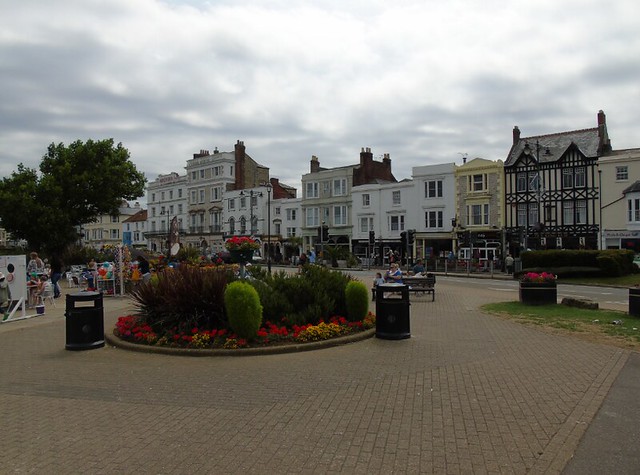
The bus dropped us off along the promenade along the seafront, which is lined with a variety of different styles of building, most of which are Listed. The row of brightly coloured pubs and shops you can see above mostly date from the 1840’s to the 1870’s, from the town’s Victorian Heydey. Indeed Queen Victoria (1819 – 1901) was a frequent visitor to the island, after she built Osborne house in the 1840’s.
The Tudor-esque building to the right is the “King Lud”, one of the few traditional pubs left in the town, built around 1900 on the site of an earlier pub, in a Mock Tudor style.

Directly opposite the King Lud, stretching far out into the water, is the world’s oldest, and the UK’s fourth longest, Pier. At 745 metres long, it is behind only the Piers at Walton-on-the-Naze, Southport and Southend, and was originally built in 1814, for purely practical purposes.
Before it was constructed, passengers trying to come ashore here would have to disembark their vessels up to half a mile offshore and walk across the sand to get into the town, as the ships would have been grounded otherwise.
The Pier was built for the ships to dock at, allowing passengers a dry access point into the town. At this time however, it was only 576 yards long, later being extended to its present length in 1833.
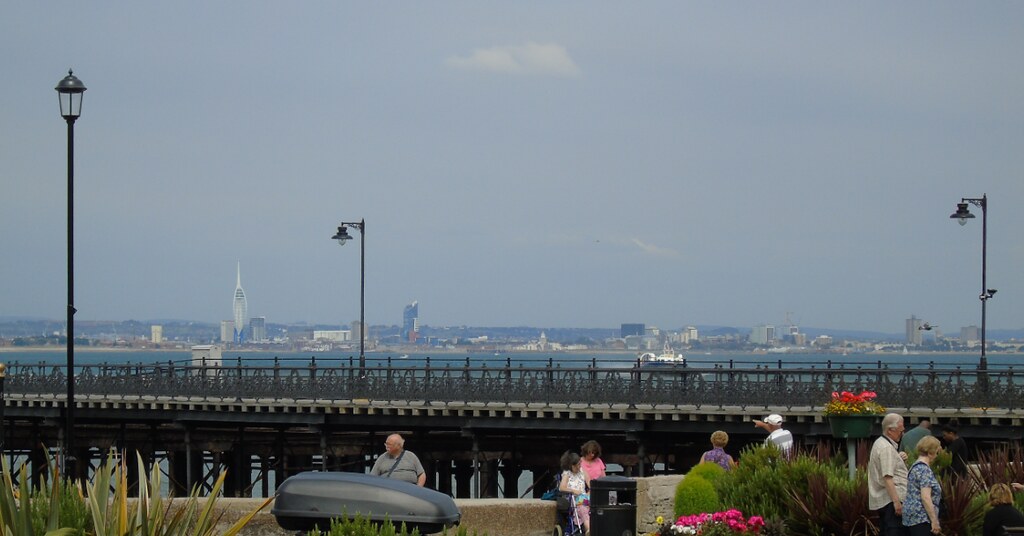
If you look past the Pier, you get an absolutely stunning view of the City of Portsmouth, four miles away on the Mainland.
To the left you can see the famous “Spinnaker Tower” the 170 metre tall Observation Tower completed in 2005, as part of Portsmouth’s Waterfront. The area surrounding it is Gunwharf Quay, where numerous high rises have also appeared. The Quay hasn’t lost its history entirely however, as you can visit the Historic Dockyards, where you will find the remains of the Mary Rose, tour the HMS Victory and explore the various exhibits.
If you look closely, just to the left of the Hovercraft behind the Pier, you can see the dome of Portsmouth’s Anglican Cathedral (17th Century, originally 11th) in White, in the old town. Surrounding it are the old fortifications, the Royal Garrison and the Round Tower on the promenade.
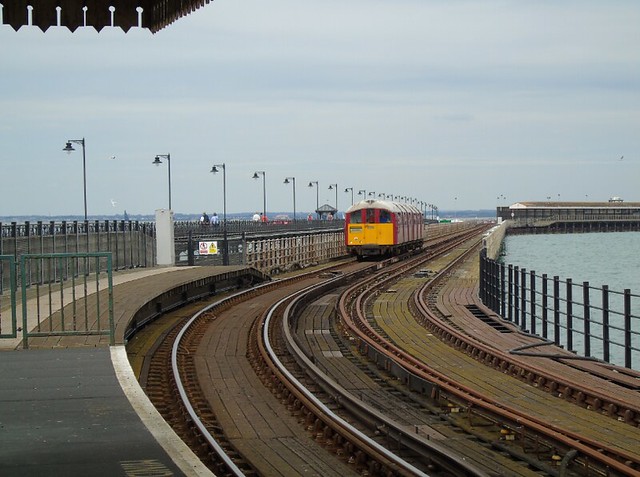
Ryde Pier is also quite unique, as the original structure was later joined by two more piers directly next to it, so todays Pier is essentially three joined together.
In 1864, the originally walkway (shown to the far left) was supplemented by a second pier which carried a tramway from the Pier Head where the ships would dock, back to the promenade. Sadly this Pier fell out of use in 1969, and has been mostly dismantled, although its remains can still be seen between the walkway and the train tracks.
The third Pier arrived in 1880, which connected the Pier Head to the Isle of Wight Railway, which trains running back to Newport and Ventnor, and from there on to Cowes. This still exists today, although the only part of the network still in operation is from Ryde Pier to Shanklin.
We get a rather interesting comparison to Portsmouth at this point as well, as the final station on the mainline, Portsmouth Harbour, is also built on a wooden pier in the Harbour area.

Some of you may have noticed the rather unusual design of the trains used on the Ryde – Shanklin route, and they are actually really interesting.
On the Isle of Wight, because of maintenance work in the 1960’s, the Ryde Tunnel is too low for standard National Rail trains, so from 1967 London Underground stock was brought in, originally the “Standard Stock” of the 1920’s/30’s.
From 1989 onwards “1938 Stock” has been used, which originally ran in London between 1938 and 1988. This makes them the oldest running trains on the British Rail Network, however they are a lovely piece of nostalgia for the island.
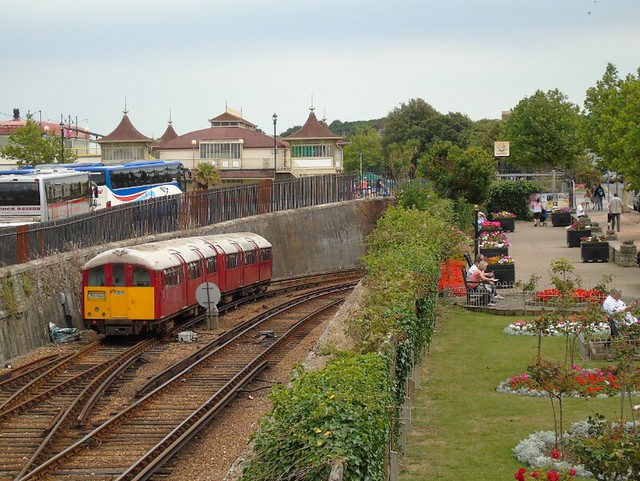
A few metres up the Promenade, we found a footbridge which leads over the railway line to the Hovercraft docking bays on the far side.
The bridge offers a cracking view of the old Underground Trains as they enter, and exit Ryde Pier, as well as the aforementioned Ryde Tunnel shown at the back of the picture. You get a good sense of just how small the trains are compared with more modern stock, helping the Isle of Wight to retain a very Victorian feel.
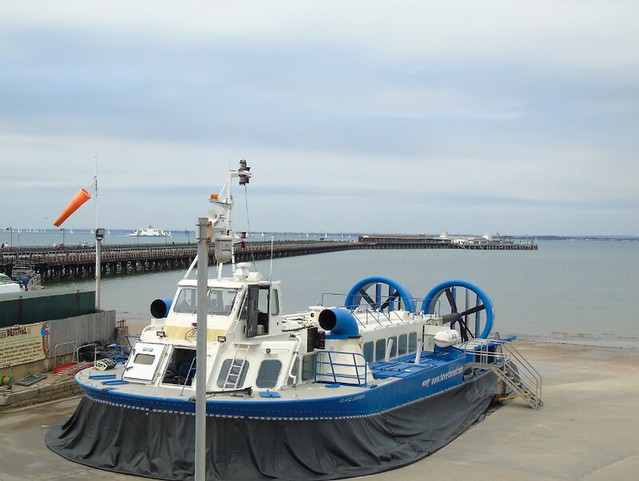
On the far side of the Bridge you can see the Hovercraft which travel over to Portsmouth, completing the journey in around 10 minutes. As far as I am aware it is one of the last, if not the last, commercial hovercraft services left in Europe. The vessel above is called “Island Express”, which entered service in 2002.
From 1965 until 1981, Hovercraft were regularly used across the English Channel known as “Seaspeed”, a joint venture between the British and French rail networks, however they were made redundant by the new Cross Channel Ferries, and later the Channel Tunnel.

Looking back from the Bridge we spotted the “Royal Esplanade Hotel” which sits almost opposite the Pier, in all its Victorian splendour.
The Hotel is actually two buildings joined together, on the site of the former Ryde Baths, demolished in 1865. Designed by Francis E. Drake, the original portion of the Hotel, to the East (left) was constructed by 1867. By the mid 1970’s, the success of the Hotel led the owner, Joseph Kemp (Son of Thomas Kemp, owner of the original Baths) to knock down the Brewery next door to build the new West Wing (right).
During World War II the Hotel was requisitioned for use by the Admiralty, under the name HMS. Osborne. It returned to public use after the War, and has been a prominent feature on the Promenade for over 150 years.
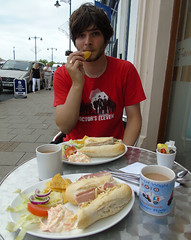
By now it was time for Lunch, so we settled down opposite the Pier for a bite to eat at the lovely “Farmhouse Pantry”. If you are looking for somewhere to enjoy the sea air, the hustle and bustle of the promenade and some great food, I would certainly give them a try!
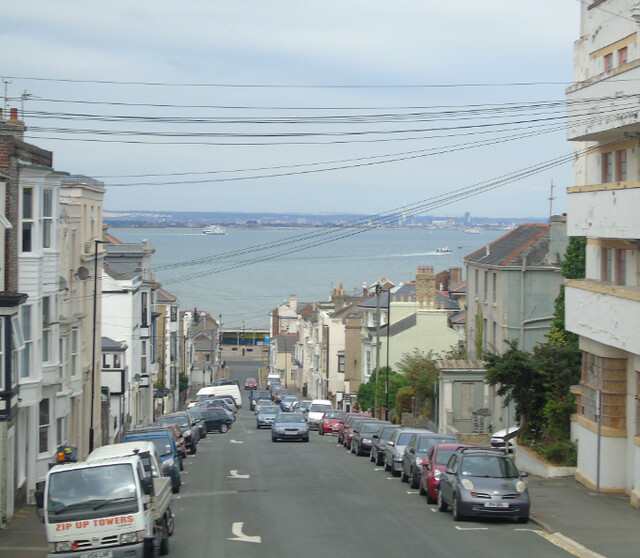
From the Promenade we trekked up the steep “Union Street” up to the town centre. Looking back, we were offered yet another stunning view, out into the Solent with Portsmouth behind (right).
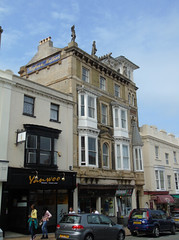
As we neared the top, we passed two particular buildings of note, starting with “Number 60 Union Street”, designed in the Italianate Style in 1865.
Across the roof stand four exotic statues, possibly representing Roman Saints or Gods. Whilst many of the buildings contemporary neighbours date from the same time period, none come close to the level of detail on its outer facade…
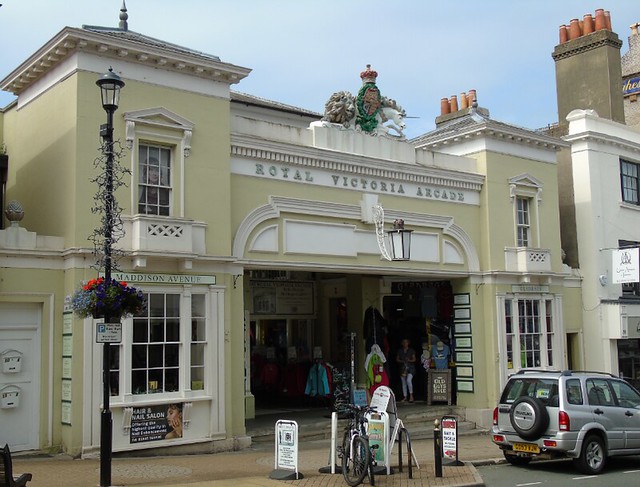
Except perhaps for Number 60’s neighbour two doors further up the hill, the Victoria Arcade. It was designed in a similar style to Number 60, Italianate, by William Westmacott in 1836.
Fitting with it’s name of the “Royal Victoria”, the British Coat of Arms featuring the English Lion/Scottish Unicorn can be seen above the doorway.
Records show it regularly fell into a dilapidated state during the 20th century, and has even come close to demolition, however today it is a much loved part of the town.
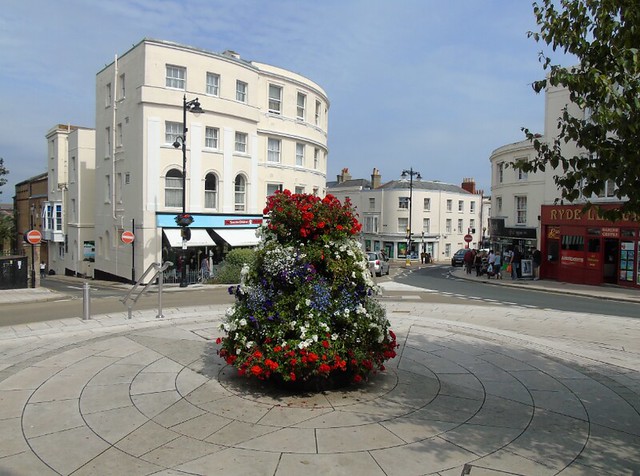
The top of the hill brings you out into St Thomas’s Square, after it’s namesake, the Church of St Thomas at the Northern End.
Various streets branch off in all directions, with lovely floral displays marking the squares centre. If you follow the various roads you will find the other major buildings in the town.
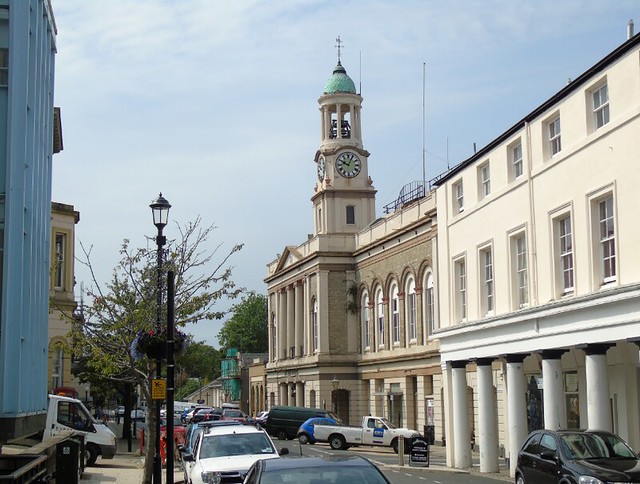
Heading West up Lind Street will bring you out at Ryde Town Hall, one of Ryde’s most impressive buildings, which began life as the Town’s Market Hall in 1831. Designed by James Sanderson, it consisted of the Market on the ground floor, with the main Council Chamber above it for the local Ryde Commissioners.
In 1868 the building was extended upon the creation of the Borough of Ryde, whose council began to meet in the building. A year later, parts of the building were used as an Art School, set up by a Mr Benjamin Barrow.
The Town Hall narrowly escaped destruction during a large fire in 1933 which gutted all but the Council Offices on the first floor. By 1990 the First Floor had been converted into a Theatre, which it remains to this day.
The Town Council now reside in a building directly opposite the old Town Hall, called “Town Hall Chambers” built in 1854.
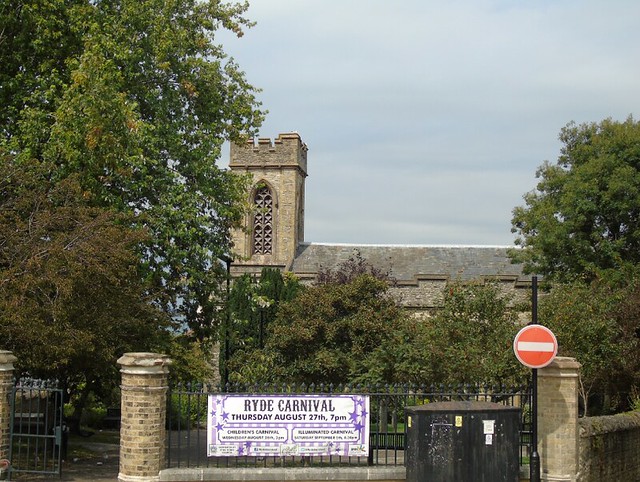
As mentioned earlier, the Northern End of the square, along St Thomas Street, is the Church of St Thomas.
Before the Church was built, local parishioners had to travel six miles to the local Parish Church in Newchurch. Because of this, Ryde’s Lord of the Manor Thomas Player built a small chapel here in 1719.
The size of the congregation was constantly growing, so much so that by 1827 a new Chapel was required, and the original was rebuilt by Thomas’s Grandson, George Player.
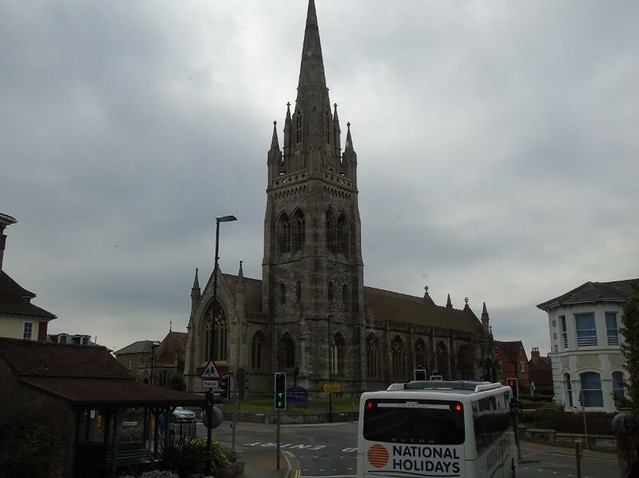
Alas it was time to head off, and we took the bus back to Newport, on to Cowes, and then boarded a ferry for Southampton.
On our way out of the town however, the bus took us past the Church of All Saints, which dwarfs any of the other smaller Churches in Ryde.
It was designed by one of my personal favourite English Architects, Sir George Gilbert Scott (1811 – 1878, English Architect responsible for St Pancras in London, the Albert Memorial and the Foreign Office, amongst others). The original design of 1872 was spireless, although in 1882 one was added to the building.
Ryde is probably my favourite town on the Island, with some amazing views along the promenade, a plethora of history and of course the almost living museum which is the old Tube Trains which run across the island.
Ryde also has the best public transport on the island, with trains running round to Shanklin on the South-East Coast, buses to Newport/Ventnor etc as well as the Hovercraft over to Portsmouth, making it a great base for travel around the Isle of Wight.
Although another days adventures had come to an end, the following day we set out again, this time to the famous, historical city of Canterbury, in Kent…
